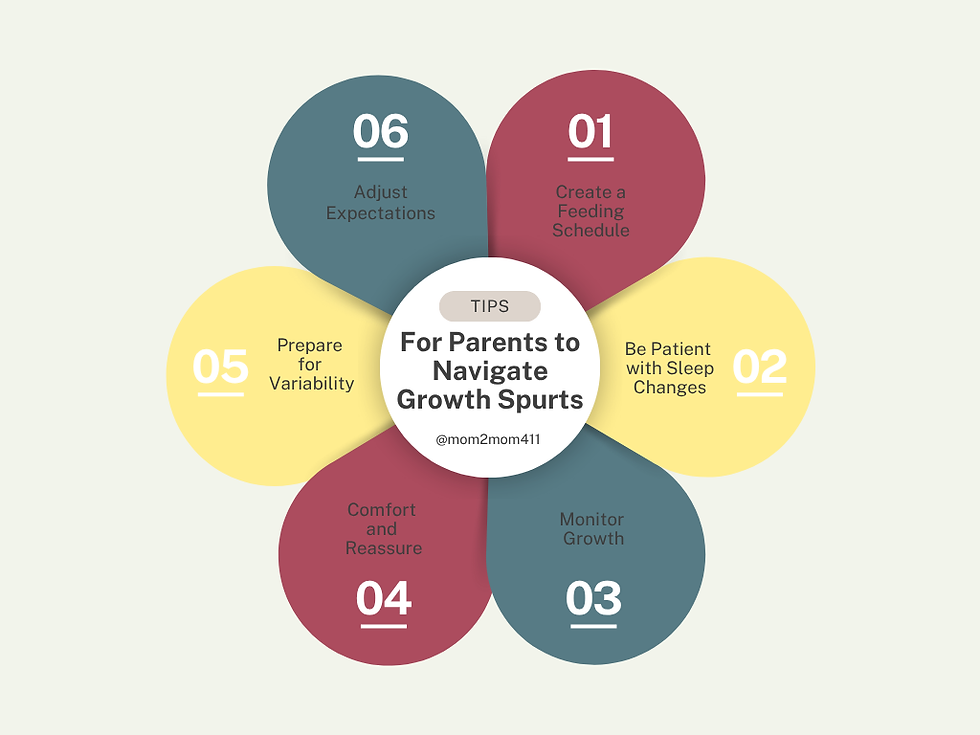Understanding Baby Growth Spurts: How to Navigate the Ups and Downs
- Dayana Hernandez
- Jun 19
- 4 min read
As a parent, it’s natural to be on the lookout for signs of healthy growth in your little one. However, growth spurts can often come along with their own set of challenges. Understanding these critical periods in your baby’s development is essential for navigating the ups and downs of parenting. This post aims to provide you with insights into when growth spurts typically occur and tips on how to cope effectively with them.
What Is a Growth Spurt?
A growth spurt refers to a rapid increase in height and weight that babies experience during their early months and years. These spurts can lead to changes not only in your baby's physical appearance but also in their behavior and feeding patterns.
Growth spurts are a natural part of development and can be influenced by various factors, including age, nutrition, and genetic predisposition. Knowing what to expect can make these times more manageable for both you and your baby.
When Do Growth Spurts Occur?
Growth spurts typically occur during specific developmental phases of your baby’s early life. The most common periods include:
Newborn Phase: 0-3 Months
During the first few months of life, babies experience rapid growth. You can expect to see significant changes in weight and length.
Six Weeks to Six Months
Another major growth spurt happens around six weeks of age and continues to around six months. This period can be characterized by increased feeding and fussiness.
Around 3 Months
At about three months, many parents notice that their babies start to become more alert and may have a noticeable increase in feeding frequency.
6-9 Months
Another growth period occurs between six to nine months. During this time, babies might become more mobile, further impacting their feeding and sleeping habits.
12 Months
The first birthday is often accompanied by a critical growth spurt that can lead to significant physical and developmental milestones, like walking.
Signs of a Growth Spurt
When your baby is going through a growth spurt, various signs may indicate this change. Here are some key indicators:
Increased Appetite
One of the most noticeable signs of a growth spurt is an increase in your baby’s appetite. They may want to feed more often than usual.
Changes in Sleep Patterns
Your baby may also experience changes in sleep patterns, becoming more fussy or restless at night.
Crankiness and Irritability
Many babies tend to be more fussy and irritable during a growth spurt. This can be attributed to discomfort caused by the rapid physical changes they are undergoing.
Physical Changes
You may also notice your baby fitting into their outfits a little tighter or their growth in height becoming apparent quite quickly.
Tips for Parents to Navigate Growth Spurts
Understanding the signs of a growth spurt is just the first step. Here are actionable tips for managing this exciting yet challenging phase:

1. Create a Feeding Schedule
Try to establish a feeding schedule that accommodates your baby’s increased appetite. Feed on demand during these times, as they may need more nutrients to support their rapid growth.
2. Be Patient with Sleep Changes
Understand that sleep disruptions are common during a growth spurt. Offer comfort and reassurance during these phases, as rest is crucial for your baby's development.
3. Monitor Growth
Keep track of your baby’s growth through regular check-ups with a pediatrician. This helps ensure that their growth patterns are within a healthy range and allows you to address any concerns early on.
4. Comfort and Reassure
During growth spurts, babies might feel restless and irritable. Providing extra cuddles, soothing sounds, or even just holding them close can help with their discomfort.
5. Prepare for Variability
Every baby is different, so be prepared for variability in behavior. What one baby experiences during a growth spurt might differ from another. Keep an open mind and flexible approach.
6. Adjust Expectations
Know that growth spurts might come with ups and downs. Adjust your expectations regarding things like feeding or sleeping, and remember that this phase is temporary.
Frequently Asked Questions (FAQs)
How Long Does a Growth Spurt Last?
Most growth spurts last a few days to a week. However, the timeframe can vary from baby to baby.
Do Growth Spurts Hurt?
While growth spurts don’t typically cause pain, the physical changes can result in discomfort. Be attentive to your baby's cues and provide comfort as needed.
Can I Encourage Growth Spurt?
Focusing on a balanced diet rich in nutrients can support your baby's growth. Consult a pediatrician for tailored advice based on your baby's specific needs.
Conclusion
Growth spurts are normal and healthy parts of your baby’s development. Knowing when they generally occur and what signs to look out for can help you provide the best support for your little one during these periods. With patience and understanding, navigating through these phases can become a bit easier. Remember, every child is unique, and as parents, it’s essential to embrace this exciting journey of growth together.
By equipping yourself with the right knowledge and strategies, you can help ensure that both you and your baby emerge from these growth spurts successful and joyful. Stay attuned to your baby’s needs, and remember that this, too, shall pass.




Comments